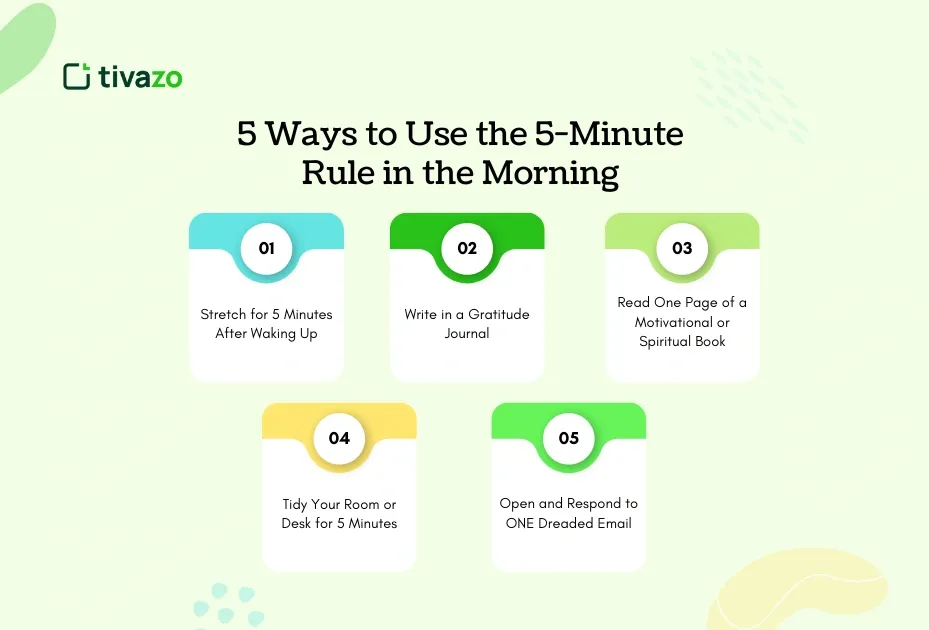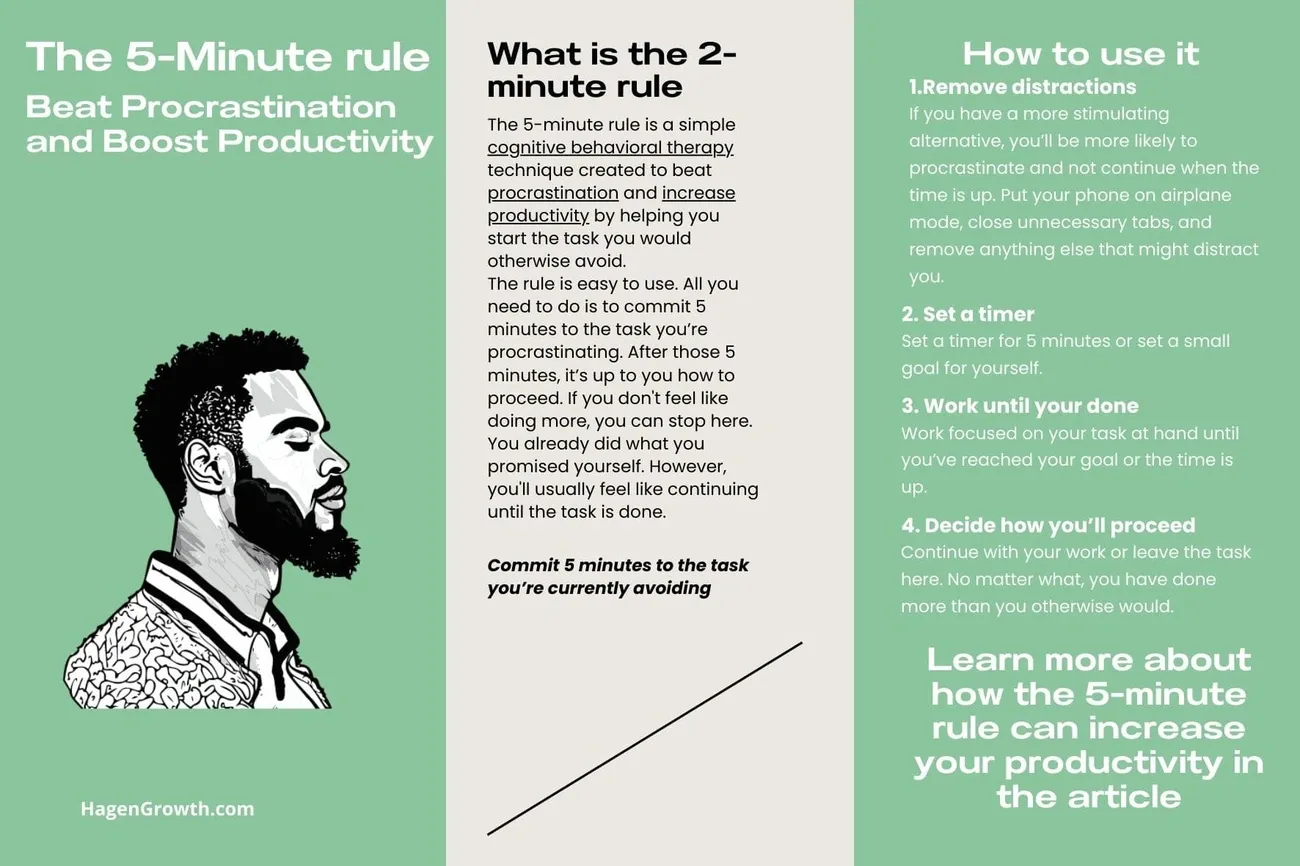How to Use the 5 Minute Rule: A Proven Way to Beat Procrastination Today
Dealing with procrastination? The 5 minute rule stands out as a proven cognitive behavioral therapy technique that makes tough tasks easier to start .
Big tasks can feel impossible to handle and need so much work that you’ll likely avoid them . The five minute rule offers a solution. This straightforward method helps you beat procrastination when you break down big projects into small, five-minute chunks . The real power of the 5 minute rule for procrastination comes from its psychological effectiveness. You just need to work on something for five minutes, and you can stop after that if you choose .
People who use the five minute rule say it’s significant to let yourself stop after these original five minutes if you don’t want to keep going . The results are amazing. Getting started builds momentum that makes it much easier to stay focused and productive once you begin .
My experience shows that procrastination stems from emotional roots, usually tied to self-manipulation and resistance . The 5 minute rule productivity technique lets us take small steps toward big achievements . This piece will show you the quickest way to use this powerful method to overcome procrastination and accomplish your goals.
What Is the 5 Minute Rule and Why It Works

Image Source: Tivazo
The 5 minute rule is a powerful cognitive behavioral therapy technique that Dr. Christine Padesky first introduced [1]. This approach asks you to work on a task for just five minutes, and you can stop or continue after that time [2].
Origin in cognitive behavioral therapy
The 5 minute rule came from cognitive behavioral therapy as a way to help people overcome lack of motivation, especially those with depression [1]. Therapists found that asking clients to commit to activities for just five minutes helped them bypass their original resistance to action. This technique has become a productivity tool that anyone who struggles with starting tasks can use.
How it helps overcome procrastination
People often procrastinate because large, undefined tasks feel overwhelming [3]. The 5 minute rule makes tasks more manageable by lowering the starting barrier—you only need to begin, not finish [2]. Your brain sees the task as more achievable with this small commitment [2].
Most people want to continue naturally after working on something for five minutes [1]. This happens because the rule breaks the procrastination cycle by reducing mental resistance [2]. Your anxiety decreases and engagement grows when you focus on starting rather than completing a task.
The Zeigarnik effect and momentum
The Zeigarnik effect explains why this technique works so well—named after psychologist Bluma Zeigarnik [4]. Our brains remember unfinished tasks better than completed ones because they create an “open loop” that needs closure [2].
Starting a task creates a specific mental tension in your brain that stays until you finish [4]. This tension makes related information easier to recall and creates a natural urge to complete the task [5].
Why five minutes is psychologically effective
Five minutes proves effective for several reasons. The timeframe feels manageable even with low motivation [2], yet it’s enough time to build momentum [6].
The brief time commitment also eliminates perfectionism—another reason people procrastinate [7]. You feel less pressure to perform perfectly when you limit yourself to five minutes, which makes starting easier.
Your brain naturally works well in short bursts of intense focus [8], which makes those first minutes productive and satisfying.
How to Use the 5 Minute Rule Step-by-Step

Image Source: Hagen Growth
The 5 minute rule needs a simple but well-laid-out approach. This technique’s beauty lies in its simplicity—anyone can start using it right away to overcome resistance and build momentum. Here’s how it works, step by step.
1. Choose a small, specific task
Start by picking a task you’ve been putting off [7]. Your task should be specific and clearly defined [9]. Don’t tackle something vague like “write an essay.” Instead, focus on concrete tasks like “brainstorm three main points” or “write an opening sentence” [9]. A specific task feels more approachable and less daunting.
2. Set a timer for five minutes
Pick your task and set a timer for exactly five minutes [3]. A clear endpoint makes it easier for you to begin [9]. Your brain sees this timed boundary as something manageable and temporary. Plus, this short timeframe takes away the pressure of perfection that often makes us procrastinate.
3. Focus fully until the timer ends
These five minutes need your complete attention on the task [7]. Get rid of distractions before you start—put your phone on “Do Not Disturb,” close extra browser tabs, and clear your workspace [9]. This focused environment helps you make the most of your short commitment and makes you more likely to continue afterward.
4. Decide whether to continue or stop
When your timer rings, check how you feel [7]. This step is vital—you should feel free to stop if you want [10]. All the same, you’ll often find you’re now “in the flow” and ready to continue [3]. This is where things get interesting—your brain has pushed past the original resistance, making it easier to keep going.
5. Repeat with consistency
Whatever you decide—to continue or stop after five minutes—consistency matters most [11]. Even five minutes each day adds up to more than 30 hours yearly [12]! As you continue with the five minute rule, note that small steps consistently guide you toward amazing results over time.
Want more productivity tools and techniques? Check out Skyline Academic Resources for complete guides and templates to boost your learning experience.
Tips to Make the 5 Minute Rule More Effective
Simple strategies can make the 5-minute rule work better, even though understanding its basics matters.
Remove distractions before starting
A distraction-free environment is vital before your five minutes begin. Your phone should go on “Do Not Disturb” mode or in another room. Close unnecessary browser tabs and clear your workspace [6]. This clean setup helps you concentrate better, even in short periods [13].
Use the 5-second rule to initiate action
Starting can be tough, even with the 5-minute rule. The 5-second rule might help – count backwards from 5, then start your task at zero [14]. This quick countdown stops your brain from finding excuses to avoid work [15].
Pair with existing habits (habit stacking)
Link your five-minute sessions to your daily routines. The habit stacking formula works like this: “After/Before [CURRENT HABIT], I will [NEW HABIT]” [16]. To name just one example, you could spend five minutes on that challenging project right after pouring your morning coffee [2].
Try the Pomodoro method with breaks
The Pomodoro Technique might be your next step once five-minute sessions become easy. This method uses 25-minute focused work periods with 5-minute breaks [17]. The 5-minute rule makes a great warm-up before each Pomodoro session [2].
Track your progress for motivation
A habit tracker app, journal, or calendar can help you monitor consistency. Your motivation grows as you see successful days stack up. Missing a day feels like breaking a winning streak [2].
Skyline Academic Resources offers expert-curated content to improve your study habits and more productivity strategies that work well with the 5-minute rule.
Common Mistakes and How to Avoid Them
Simple productivity techniques can fail when we use them wrong. The 5 minute rule works well, but it has several pitfalls that reduce its effectiveness.
Expecting too much beyond five minutes
People often sabotage their progress with unrealistic expectations. You don’t deal very well with the 5 minute rule when you believe you must finish everything right away. This sets you up to fail [2]. Note that change takes time. The real power comes from small actions that build up over time.
Using it as a trick instead of a tool
A basic mistake happens when you turn the rule into self-manipulation. This occurs when you say “just five minutes” but expect yourself to work longer [18]. You create an internal disconnect that breaks your self-trust. The better approach is to stay honest about what you want to achieve.
Ignoring your emotional resistance
Procrastination stems from emotions rather than poor time management [10]. Anxiety, perfectionism, and fear of failure often hide behind procrastination. The 5 minute rule works best when you face these emotions head-on. Think over what specific fears drive your resistance and tackle them directly.
Not setting clear boundaries with yourself
Your ability to stop after five minutes matters as much as getting started. Clear boundaries with yourself build vital self-trust [18]. You’ll resist starting if you promise “just five minutes” but never let yourself stop. Good personal boundaries are the foundations of consistency and green progress [19].
Conclusion
The 5-minute rule works as a powerful solution to procrastination. It targets the emotional resistance we feel when big tasks seem overwhelming. My experience shows this technique works because it removes the pressure to be perfect or complete everything at once while building real momentum. Starting any task is always the biggest hurdle.
This approach works so well because it matches how our brains naturally function. The Zeigarnik effect creates an “open loop” in our minds that we want to close once we start something. This explains why those first five minutes often turn into longer productive sessions without extra push.
You can use this simple and flexible technique for almost any project. It works for studying, household chores, and creative projects. You can boost your results by combining it with other methods like habit stacking or the Pomodoro Technique.
Note that consistency matters more than intensity when you use the 5-minute rule. Small daily five-minute commitments add up substantially over time. You must honor your promise to stop after five minutes if you want to – this builds vital self-trust and makes future sessions easier to start.
Want to learn more productivity techniques beyond the 5-minute rule? Check out Skyline Academic Resources for time management and focus-building tools that help you succeed academically.
Next time a task feels daunting, try this simple approach: Set your timer for five minutes, clear away distractions, and just begin. This technique might seem too simple, but its psychological impact makes it a game-changer for anyone who struggles with procrastination. Those small five-minute commitments today will become finished projects tomorrow.
FAQs
Q1. How does the 5-minute rule help overcome procrastination?
The 5-minute rule helps overcome procrastination by breaking down overwhelming tasks into a small, manageable commitment of just five minutes. This approach lowers the barrier to starting, reduces anxiety, and often creates momentum that leads to continued work beyond the initial time frame.
Q2. Can the 5-minute rule be applied to any task?
Yes, the 5-minute rule can be applied to virtually any task or project. Whether it’s studying, household chores, or creative endeavors, committing to just five minutes of focused work can help initiate action and overcome initial resistance.
Q3. What should I do if I want to continue working after the 5 minutes are up?
If you feel motivated to continue working after the initial 5 minutes, you’re free to do so. However, it’s important to honor your original agreement with yourself. Assess how you feel and decide whether to keep going or stop, knowing that you’ve already accomplished your goal of getting started.
Q4. How can I make the 5-minute rule more effective?
To enhance the effectiveness of the 5-minute rule, try removing distractions before starting, pairing it with existing habits (habit stacking), using a timer, and tracking your progress for motivation. You can also combine it with other techniques like the Pomodoro method for longer work sessions.
Q5. What’s the biggest mistake people make when using the 5-minute rule?
The biggest mistake is using the 5-minute rule as a trick rather than a tool. Some people commit to “just five minutes” while secretly expecting themselves to work much longer. This creates an internal disconnect and undermines self-trust. It’s important to approach the technique honestly and honor the ability to stop after five minutes if you choose to.



